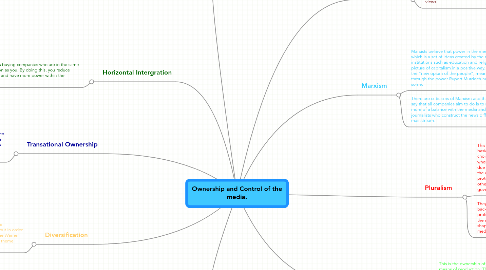Ownership and Control of the media.
by Jonathan Hatzimasouras

1. Horizontal Intergration
1.1. This involves buying companies who are in the same media section as you. By doing this, you reduce competition and have more power within the market.
2. Transational Ownership
2.1. The process of globalisation through the media. This has been increasing where companies have been expanding abroad in order to grow within the global market. An example of this is Sony, who now have expanded in all the continents of the world
3. Diversification
3.1. This is where a company owns different kinds of things which are associated with the media. Some companies choose to branch out in order to have more power in different sections of the media. AOL Time Warner owns not only television and film companies, but they also own theme parks and other things which can be related to the media
4. Synergy
4.1. Big businesses bring together different sections of their ownership in order to expand their power of one thing within each section. For example Superman started as a comic, and developed to a cartoon, a film an action figure and a lot more.
5. Neo- Marxism
5.1. There are criticisms of Neo-Marxism such as that there are media professionals who are now women or from an ethnic minority background. Also, the development of new technologies expands the range of views, such as the internet, instead of what Neo-Marxists say.
5.2. Unlike Marxism, Neo- Marxists go beyond social class, and involve things such as gender and ethnicity. More importantly, they used the term hegemony, to show the dominance of certain ideas. The media, is seen as a key role to increase this hegemony. Neo - Marxists examine the control of the media professionals. They believe they are products of the institution, as they all tend to have similar features, such as being middle class and white. Some theorists researched the way media professionals create media products which reinforce the power structures of society. Others such as Fairclough looked at programs which showed an ideal world, where the police were in control and co-operated with the people, but the program didn't interview the communities who felt alienated from the police. He believed that the media professionals created a language which affected the way people thought.
6. Concentration
6.1. The process where ownership is controlled in fewer hands. This can be seen with Rupert Murdoch who owns smaller organisations such as The Times and The Sun. Some sociologists see this as a threat to democracy, as it sets a smaller number of views.
7. Vertical Intergration
7.1. This is the ownership of all means of production. This increases control and cuts costs, which can be seen with many organisations such as Disney.
8. Marxism
8.1. Marxists believe that power in the media lies within the ruling class. They believe they use the "ideology", which is a set of ideas created by the ruling class, for the people. This ideology is then reinforced by social institutions such as education and religion. Miliband (1969), believed that ruling class created a false picture of capitalism in a positive way. He said, based on Karl Marx's ideas on religion, that the media, is the "new opium of the people", meaning that media creates an illusion of happiness. This can be seen through the power Rupert Murdoch has who has been even named as the "Phantom Prime Minister" by some.
8.2. There are criticisms of Marxism and the media. For example, some say that all companies aim to do is to make profit, and there is more of a balance with the media and the audience. Also, there are journalists who construct the news differently from the mainstream.
9. Pluralism
9.1. This view is supported by the media professionals, who basically say that there is diversity within the media, and choice within the media products. They operate in a market where what they produce will attract a large audience, and due to competition of success there is diversity. They use the concept of Fourth Estate, which portrays the media as a protector of democracy, because it acts as a check for the other three states (parliament, judiciary, and the government).
9.2. They do not address the background of the media professionals, and they ignore the role of the owners in shaping the content of the media


